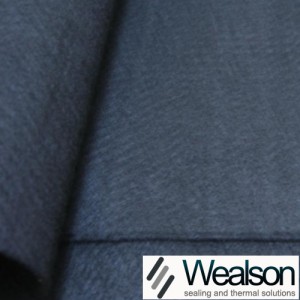
 Carbon felt and graphite felt are designed for use as high temperature insulation in vacuum furnaces and inert gas furnaces. The needle-punched PAN based carbon and graphite felt is light in weight and has low thermal conductivity. It can be used in oxidizing temperatures up to 400 °C and in vacuum or protective atmospheres up to 3200°C
Carbon felt and graphite felt are designed for use as high temperature insulation in vacuum furnaces and inert gas furnaces. The needle-punched PAN based carbon and graphite felt is light in weight and has low thermal conductivity. It can be used in oxidizing temperatures up to 400 °C and in vacuum or protective atmospheres up to 3200°C
Thermal properties of carbon felt:
Low thermal conductivity
Low Specific heat
Permits rapid heating and cooling of furnace
High thermal stability
In oxidizing atmosphere up to 350 Centigrade, in protective atmosphere or vacuum up to about 3000 centigrade.
Favourable resistivity
Coupling in an inductive field occurs only above 12kHz.
Easy of handling
Felt can be cut with scissors or knife and adapts to small bending radii.
Favourable surface properties
Chemical properties of carbon felt:
For hot and/or corrosive gases and liquids
For molten metals (no wetting)
Catalyst support: simplified recovery of the catalyst by heat treatment
Porous electrodes: for accumulators and fuel cells
Applications of carbon felt:
For resistance-or induction heated vacuum furnaces and inert gas furnaces, such as degassing furnaces, brazing furnaces, soft and bright annealing furnaces, sintering furnaces for hard metals, carburising furnaces, laboratory graphitising furnaces.
For inductively heated melting and heat treatment furnaces, in which a proportion of the ceramic insulating material is replaced by felt in order to increase the electrical efficiency and prevent the liquid metal from coming into contact with the induction coil in the event of crucible fracture (no wetting).
For nuclear reactor technology (small cross-sectional area for neutron absorption).
Felt is applied as thermal insulation, as filters, and as catalyst support.
It can also be applied for porous electrodes.
| ITEM | INDEX | ||||
|---|---|---|---|---|---|
| Trademark | Rayon-based Carbon Felt LTZ-124-5 | Rayon-based Graphite Felt LTZ-124-6 | PAN-based Carbon Felt LTZ-124-3 | PAN-based Graphite Felt LTZ-124-1 | |
| Material | RCF | RCF | PAN-CF | PAN-CF | |
| Bulk density(g/cm3) | 0.10-0.12 | 0.08-0.10 | 0.14-0.15 | 0.12-0.14 | |
| Carbon(%) | ≥98.5 | ≥99 | ≥98.5 | ≥99 | |
| Thermal conductivity(1150oC W/m .k) | 0.08-0.15 | 0.06-0.14 | 0.12-0.18 | 0.08-0.14 | |
| Tensile Strength (Mpa) | 0.13 | 0.1 | 0.15 | 0.14 | |
| Crushing stress(at 10% compression N/cm2) | 6-10 | 5-8 | 8-12 | 8-10 | |
| Ash(%) | ≤0.05 | ≤0.005 | ≤0.05 | ≤0.005 | |
| Processing temperature | 1200oC | 2300oC | 1200oC | 2300oC | |
| Operating Condition in the air | ≤400oC | ≤400oC | ≤400oC | ≤400oC | |
| Operating Condition in the vacuum | ≥1500oC | ≥2300oC | ≥1500oC | ≥2300oC | |
| Operating Condition in the vacuum In the inert atmosphere | ≥2300oC | ≥3300oC | ≥2300oC | ≥3300oC | |
| Spec | lenght (m) | 16 – 18 | 9 – 12 | ||
| Wide (mm) | 1000-1300 | ||||
| Thickness (mm) | 3/5/8/10/12 |
